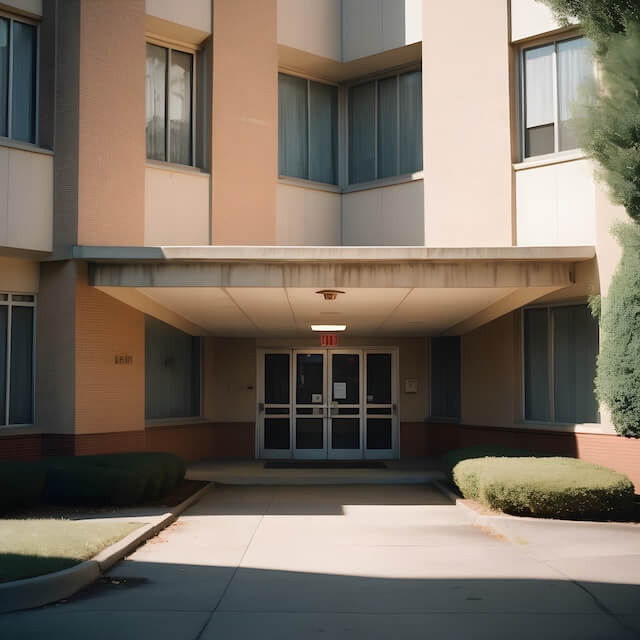Many people experiencing a serious addiction problem require residential inpatient treatment. They may have already had many failed attempts at stopping or moderating their substance use addiction, or they need a circuit breaker so they can be removed from their current environment.
Residential rehab is the most severe form of intervention for the treatment of drug and alcohol dependence. This means it should always be the last option for anyone requiring treatment.
Regrettably, because of popular culture, movies, music, TV, and celebrities, residential rehabs are viewed by society as the first point of contact for an individual requiring treatment for their addiction.

QUICK FACTS:
- Recidivism rates in all residential rehabs are very high.
- In a standard government-funded residential treatment facility, the average recidivism rate is between 50% and 80%. Around 50% of the same people have been to either the same treatment facility or another twice before.
- For some private hospitals and residential insurance-based rehabs and detoxes, these rates can be even higher. It is not uncommon for a private hospital rehab and/or detox to either have a 100% recidivism rate at a particular point in time or for numerous clients to enter the same facility two to three times in one year.
- Many private rehabs that do not take insurance claims are slightly likely to have lower recidivism rates on average. Firstly, because people are paying cash, it could be cautiously argued that they have more incentive and are more invested in the process. These private rehabs are costly, and most of these rehabs are connected to 12-Step organisations and meetings as part of their program’s, that ordinarily provide a lot of community support for some people post-treatment.
- There is no accurate measurement for residential treatment outcome anywhere, whether it be private or publicly provided. Some publicly funded NGO’s conduct surveys, and many utilise evidence-based practice as part of their therapeutic models, but as for the long-term outcomes of addiction treatment anywhere in the world, no such valid measurement exists. It’s almost impossible to collect such data.
- The essence of 12-step mutual aid is the free fellowship and support provided by individuals who have gone through similar experiences. When fees are introduced, the focus shifts from mutual support to financial transactions, potentially diluting the sense of community and shared understanding that is crucial to recovery.
- Financial barriers have a profound impact on access to recovery. Addiction does not discriminate based on socioeconomic status, yet the cost of rehab programmes often creates a barrier for those who lack the financial means to pay for treatment.
- Currently, there is no genuine, rigorously tested, proven, or scientifically based evidence to suggest residential rehab even works at all.

How can this be?
How could people spend so much time, money, and research on such things without any genuinely clear guidelines?
It is a practical and economic impossibility to measure treatment outcomes accurately, particularly long-term treatment outcomes of six months or more after a client has left a treatment facility.
It is even more so when organisations themselves are tasked with measuring their treatment program’s effectiveness six months after clients have exited their program.
First, the facility would have to decide what it is they are measuring.
Sobriety?
Engagement with friends, family, and society?
Other new addictive behaviours?
Re-occurrence of poor mental health or new mental health problems?
Employment status?
Maladaptive behaviour?
Housing?
Biological Health?
New health problems?
Economic stability?
Education/training?
Any life goals?
Attending health appointments?
Ongoing health problems?
Personal relationships?
Leisure time and recreational activities?
What is the current standard of living?
A new drug problem, but not serious?
A new drinking problem, but not serious?
Or a new, severe drinking problem?
Living Environment?
Are spiritual or religious needs being met?
The actual potential list for measuring an individual’s quality of life post-treatment is quite extensive and certainly does not lend itself easily to any identifiable quantitative data.
So what happens in reality?
We have self-reporting surveys and questionnaires for people coming out of a severe mental health disorder intervention (rehab). Perhaps the most unreliable, conflicted, compromised, and tainted data that could ever be gathered.

The big question is why?
This is not to say there are no unproven therapeutic techniques, approaches, styles, different modalities, or collaborative approaches that work.
There are many.
Different types of medication have proven very useful in the treatment of substance use disorders.
Health professionals working collaboratively with one another, alongside allied health networks, and with the clents family and support network have proven very useful in treating substance use disorders and related mental health problems.
Engaging in work, study, or volunteering post-treatment has proven beneficial for many people post-treatment. (Over fifty percent of anyone involved in volunteer work is in a state of recovery from a biological or mental health issue.)
CBT, motivational interviewing, psychoeducation, and psychotherapy have proven beneficial for people in treatment and post-treatment.
Urine testing, mutual aid groups, support groups, out-patient programs, and group therapy have also proven to be somewhat helpful for people in treatment and post-treatment.
There is a vast array of frameworks, therapeutic models, and approaches that have proven to be beneficial. To assume that every client has either the opportunity, cognitive readiness, understanding, or capacity to engage in or be a part of all of these approaches is an unreasonable expectation.
However, there are residential treatment facilities offering individuals and families complete fiction and pure fraudulent fantasies in relation to recovery goals. Any rehab selling guaranteed success rates or success rates of any kind is fraud and should be reported and written about extensively so their nonsense can be scrutinised.
It is a highly unusual situation.

So what's left?
In Australia, 98% of all public-funded residential rehabs are NGO‘s that have to apply to the government for funding on a fairly regular basis. Organisations with the appropriate resources to apply for grants tend to receive most of the money regardless of treatment measurement outcomes. “Episode Of Care” is the only measurement Government agencies are interested in. How many clients are accessing the service?
Without their long waiting lists, government funding bodies might believe people are not interested in accessing their services. They need the waiting list to enhance their own hype. Organisations have to apply for funding every few years, further complicating their ability to provide high standards on a consistent basis.
Then there are the insurance-based private hospitals, religious-based residential rehabs (the government indirectly funds many), spiritually based rehabs, where many receive no funding, community-based NGO’s, which accept little to no funding, and then there is the massively growing private sector.
The majority of the private sector is managed and staffed by members of 12-Step organisations.Mainly Alcoholics Anonymous and Narcotics Anonymous.
These organisations have no direct involvement in the rehabs other than perhaps through their voluntary hospital and institution information sessions. This is when AA or NA members go out to hospitals and detoxes and tell their story of recovery.

AA and NA are not professional organisations. Strangely enough, 12-step meetings and private rehabs offer each other a form of mutual validation or recovery currency that can potentially advocate the effectiveness and significance of each other as solid gold standards for recovery practice, without any measurable data.
They are not connected to rehabs in any official capacity, as they are community mutual-aid groups.
Although many private rehabs have their own 12-step meetings, and some of these are open to the general public, it gets confusing (deliberately so).
Many non-profits and NGO’s also offer attendance at 12-step mutual aid groups as part of their programs, but these rehab programs are free for the most part.
12-step mutual aid groups do not have counsellors or trained facilitators at their meetings, unlike SMART Recovery meetings, which do have a trained facilitator at the meeting and are also free and entirely based around evidence-based practices.
It is a little wonder why SMART recovery meetings are growing quickly around the world.
It is 100% free to attend any 12-step meeting, and most importantly, it is anonymous, which is why it would be challenging to ascertain or measure the effectiveness of their community support program.
The effectiveness of 12-step meetings is anecdotal, and the long-term effectiveness of attending 12-step meetings appears contradictory. Isn’t the purpose of getting clean and sober so you can get on with your life and embrace the world around you?
AA is a community support program and is under no guidance from any peak bodies, health professionals, or government, and each group within the 12-Step program is autonomous, meaning they can deliver their version of the 12-Steps the way each group would like.
The entire program is based on a book written nearly 85 years ago, and that in itself might explain many of its shortcomings.
So we have private rehabs with unqualified staff that sell free programs.
These private Rehabs assert that if their clients do not surrender and hand themselves over to God or a higher power, it could be impossible to overcome this terminal disease of addiction.
The scariest thing about these private rehabs is that a new one opens up every few weeks, selling people the same free program about God.
12-step program’s also contain within them many cult like predatory practices, that further traumatise an already vulnerable and impressionable client who is just trying to get clean.
Essentially, it is a process of spiritual conversion, and private rehabs can easily abdicate responsibility for a client by highlighting the fact they have not prayed enough, surrendered to a higher power, or been fully committed to this spiritual process.

It could be worse, and in fact, it is.
Many other rehabs are owned and operated by organised crime syndicates, dodgy medical practitioners, corrupt people in business, people who self-published books about how they got sober, and the list goes on and on.
It would be inaccurate to assume that all 12-step rehabs are bad, that all government-funded rehabs are good, or that insurance-based rehabs are a bad joke.
Likewise, you cannot assume that the reason people go to insurance-based private hospital rehabs is only to access impractical levels of freedom (making it easier for them to relapse), access to strong medications, cable TV, and excellent food, as nothing is that simple.
In Australia, some private hospitals that accept insurance and apply the principles of 12-Step program’s are also, some of the best rehabs in Australia.
Many government-funded rehabs are also excellent and are continually reviewing, updating, and validating their treatment programs.
There is also great success with some religious-based rehabs, and anecdotally, 12-Step programs themselves are useful for some people.
However, 12-Step meetings have proven to be hazardous places for some women, people with dual-diagnosis disorders, and anyone taking medications.
It could become very likely they will receive unqualified, unsolicited advice about the medication they were taking from a well-meaning group attendee.
There is no right or wrong, good or bad.
There are fictitious and unethical practices and corruption, but the ultimate success should be supported and vindicated.
The treatment has always come down to the individual. What are they prepared to do to arrest their disorder and sustain change in their lives?
Regrettably, this can happen in the worst, most horribly fraudulent rehab in the world or in the most effective and up-to-date evidence-based programme.
The difference is, and this is key.
The evidence-based program does not rely on higher powers, God, or spiritual transformation but only on what has been proven to be effective.
For good or for bad, this takes emotion out of the equation.
If I had a severe physical health problem, I would not need to see a doctor who had recovered from the same illness (although that might be good). However, I would be reasonably concerned if he asked me to pray instead of accepting proven medical advice for treatment.

